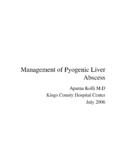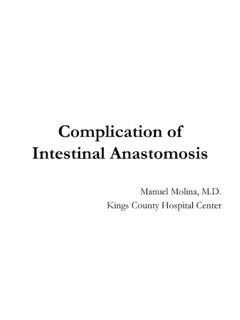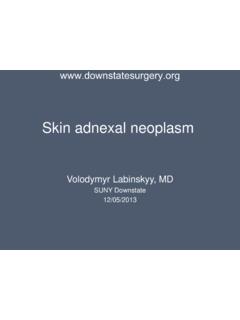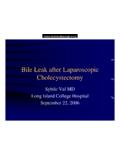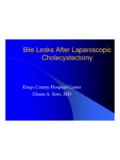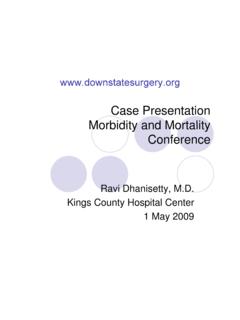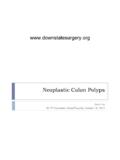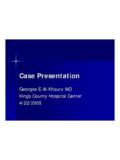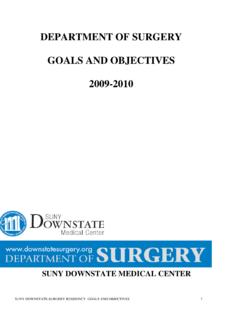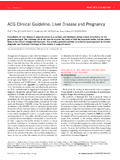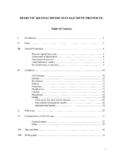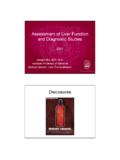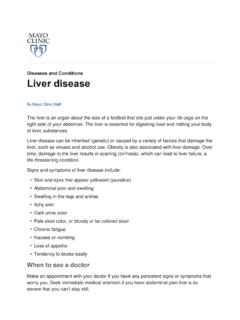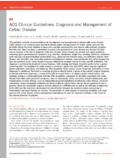Transcription of www.downstatesurgery.org Perioperative …
1 Perioperative management of patients with Sickle Cell Disease November 29th, 2012 David Vivas, MD - History CC: RLQ pain HPI: 14 y/o female with h/o Hg SC presented to ED with 4 days h/o abdominal pain, initially diffuse but later locating to RLQ, associated with nausea, vomiting x 4 (nonbilious/nonbloody) and back pain. Patient denied fevers, diarrhea. - History PMH: SCD, multiple hospital admissions for pain crises in Jamaica PSH: None SHx: Patient recently emigrated to the US from Jamaica (2 weeks prior to presentation) FHx: Father, mother, brother with SCD NKDA - PE VS: T , HR: 125, BP: 111/69, RR: 30, SaO2: 99% AAOx3, In mod. distress Scleral icterus CV: RRR, tachycardic Chest: CTA, b/l Abdomen: Mod. distension, + BS, soft, diffusely TTP. + guarding on RLQ Ext: No edema CBC: > <226 Ret: BMP: 137 <107 LFT: 15/13 Abdominal US Splenomegaly, mild enlargement of the liver, normal appearing gall bladder Patient was admitted to Pediatrics IV fluids IV Abx Pain control Pediatric Surgery Consult: Recommend CT abdomen/pelvis IV/PO contrast CT scan Acute appendicitis, suspected perforation.
2 No discrete abscess Moderate splenomegaly. No splenic lesions Scan Scan Scan Labs CBC: > <162 Ret LFT: 4/27 Hematology Evaluation Pediatric Hematology Consultation: Hb SC patient with unusually difficult course in Jamaica (No ACS reported) with urgent need for laparotomy Concern for some sequestration due to drop in Hb, tender liver and spleen, rising Tbili Hematology Evaluation Pediatric Heme Consultation Recommendations: Exchange would be invasive and delay surgery Transfuse 2 units RBC s over 2-3 hrs Avoid over-hydration Aggressive pulmonary toilet, IS PICU admission Operative Course 2 units of PRBC s were ordered Patient was taken to OR for emergent appendectomy after 1st unit PRBC was being administered Operative Course Open Appendectomy 200 ml pus drained upon entering peritoneal cavity Appendix was necrotic, covered with fibrin, perforated Wound was left open Post op Course Patient was extubated and transferred to PICU NGT IV Abx (meropenem) Incentive spirometry Pain control Post op Course POD # 1- 6 patient improving Pain well controlled Febrile on POD # 1 Low grade fever on POD # 3 Afebrile after POD # 3 Bowel function returned POD # 2 Diet advanced to regular by POD # 4 Wound was closed on POD # 4 (delayed primary closure)
3 Post op Course POD # 7 patient was transferred to regular pediatric floor POD # 8 10 WBC noted to rise from to POD # 10 surgical wound was opened POD # 11 WBC CT Abd/Pel: x cm abscess in LLQ anterior to psoas muscle Scan Post op Course Patient underwent IR drainage of intra-abdominal collection By POD # 18 patient had finished course of Abx and remained afebrile, tolerating a diet, with a clean surgical wound. WBC remained WNL Patient was D/C home on POD # 19 management of patients with Sickle Cell Disease Science/Genetics Syndromes Overview clinical manifestations for surgical treatment Considerations Principles Cell Dz: Basic Science Hemoglobin is a tetrameric protein consisting of 2 alpha ( ) and 2 nonalpha polypeptide chains ( , , , ) attached to 4 iron-containing heme complexes Sickle cell anemia is a genetic disorder caused by an autosomal co-dominant single gene defect in the -globin chain of HbA, which produces HbS HbS is formed by the substitution of glutamic acid (negatively charged) by valine (nonpolar) in position 6 of the -globin chain of hemoglobin has 2 interrelated effects: - The hemoglobin S molecule is unstable and degrades more rapidly - The deoxygenated form is insoluble and precipitates out of solution in the cytosol Sickle Cell Dz.
4 Basic Science HbS becomes insoluble at O2 tension in venous range kPa Upon deoxygenation, HbS tends to crystallize and precipitate The precipitation and polymerization of hemoglobin deforms the cell The distortions include the characteristic sickle shape that gives the disease its name Sickle Cell Dz: Basic Science Cell Dz: Basic Science The term sickle cell anemia (SCA) refers to HbSS disease SCA occurs if HbS is inherited from both parents (HbSS genotype) Sickle Cell Dz: Basic Science Other forms of sickle cell disease may occur if HbS is inherited from one parent and another abnormal hemoglobin, is inherited from the other parent Hemoglobin C (HbSC) -thalassemia (HbS -thalassemia) Sickle Cell Dz: Basic Science Hemoglobin C is a -chain variant, most common in people of West Africa The combination with another mutation (ex HbSC disease) produces symptoms of sickle cell disease The term sickle cell disease (SCD) refers to all of the genotypes (HbSS, HbSC, HbS -thalassemia) Sickle Cell Dz: Basic Science SCD is the most common inherited blood disorder in the United States, occurring in 1.
5 2,647 births SCA accounts for 60% to 70% of SCD in the SCD occurs in 1 in every 500 African Americans About 8% of African Americans are carriers SCD In sickle cell trait (SCT), there is inheritance of one Hb S allele (Hb AS) 25% to 30% of neonates in western Africa are carriers of the SCT Approximately 8% of African Americans have SCT Cell Syndromes Overview Sickle cell disease is characterized clinically by a shortened life span Median age at death is approximately 42 years for men and 48 years for women Affected patients characteristically are asymptomatic until approximately 4 to 6 months of age Cell Syndromes Overview Disease manifestations are most severe in patients with homozygous Hb SS SCT (Hb AS) is often asymptomatic but sickling can occur at very low oxygen tensions (below 3 kPa) Cell Syndromes Major Clinical Manifestations Anemia Chronic, reasonably well-compensated hemolytic anemia, reticulocytosis Erythrocytes are destroyed randomly, with a mean life span of 17 d (normal: 110 to 120 d) Acute severe anemia.
6 Splenic sequestration crisis Aplastic crisis Hyperhemolytic crisis Cell Syndromes Major Clinical Manifestations Acute painful episodes (sickle cell crisis) Most common May be precipitated by weather conditions, dehydration, infection, stress, exercise, alcohol consumption, obstructive sleep apnea Up to half of episodes have no identifiable cause Can affect any area of the body, with the back, chest, extremities, and abdomen being most commonly affected Can range from trivial to excruciating Cell Syndromes Major Clinical Manifestations Acute chest syndrome (ACS) Most common form of acute pulmonary disease Second most common cause of hospitalization in SCD and the leading cause of death Defined as the new appearance of an infiltrate with pulmonary symptoms in a patient with SCD Cell Syndromes Major Clinical Manifestations Acute chest syndrome (ACS) Fever, chest pain, and cough The etiology of ACS is multi-factorial ACS is a frequent postoperative problem Typically detected 2 3 days postoperatively and last for 8 days Cell Syndromes Major Clinical Manifestations Hyposplenism or functional asplenia Infections Osteomyelitis Cerebrovascular events Osteonecrosis (also called avascular necrosis)
7 Renal complications Renal failure in up 18 percent of patients Cell Syndromes Major Clinical Manifestations Hepatobiliary complications Acute hepatic ischemia, benign cholestasis, hepatic sequestration crisis, acute and chronic cholelithiasis secondary to pigmented gallstones Priapism SCD patients undergo certain procedures at a higher rate than the general population Cholecystectomy Splenectomy Femoral head reconstruction due to avascular necrosis Joint replacement Craniotomy due to sub-arachnoid hemorrhage Sickle Cell and Surgery General Considerations Surgery requiring GA may increase risk of Perioperative sickling and vaso-occlusive events in SCD Sickle cell crises may be precipitated by: Surgical trauma and inflammatory response to tissue injury Hypoxia associated with ventilatory depression ( pain, opioids etc) Dehydration induced by reduced oral fluid intake Sickle Cell and Surgery General Considerations Triggers Hypoxemia Acidosis Hypothermia Dehydration Low perfusion states Infections The Perioperative period is critical for the patient with SCD Factors increasing Perioperative risk specifically for SCD patients include.
8 Expected decrease in Pa02 Pre-operative opioid tolerance Fluid compartmental shifts Disruption in thermoregulation Sickle Cell and Surgery General Considerations complications in SCD Painful crisis Acute chest syndrome (ACS) Hyperhemolytic crisis Aplastic crisis Renal complications Sickle Cell and Surgery General Considerations complications in SCD Incidence of acute sickle cell exacerbations (n=1079 procedures) 0% for tonsillectomy for hip surgery for myringotomy for intra-abdominal nonobstetric surgery for cesarean section and hysterectomy for dilation and curettage Koshy M, et al. Surgery and anesthesia in sickle cell disease. Blood 1995;86(10):3676 84 Sickle Cell and Surgery General Considerations Reversal of the sickling process is difficult Focus is on prevention of vaso-occlusive crisis Sickle Cell and Surgery General Considerations assessment strategies Control regulation Control Blood Transfusions Sickle Cell and Surgery management Principles Assessment and Workup Identify the frequency, pattern, and severity of recent sickle exacerbations, and the presence and extent of organ damage Hemoglobin level, WBC w/diff, reticulocites, LDH, LFT CXR, Pulmonary function tests, ABG EKG.
9 Or neurologic imaging may be indicated Sickle Cell and Surgery management Principles Dehydration is a recognized cause of sickle cell related complications patients should be encouraged to drink clear fluids freely until as close to surgery as possible Preoperative fasting guidelines have been shortened to allow for oral intake of clear fluid up to 2 hours preoperatively There is a lack of evidence to support admission for intravenous hydration preoperatively beyond that appropriate for the surgical procedure and the degree of renal dysfunction Sickle Cell and Surgery management Principles In SCD patients pain control is of utmost importance for two reasons Painful crisis is a common complication of SCD that can be brought on as a result of the physiologic stress of surgery patients with SCD often experience some degree of chronic pain and may be on a regular analgesia regimen before having an operation Sickle Cell and Surgery management Principles Increasingly, patients with SCD who experience acute pain crisis are treated with a PCA pump delivery system for opiates It is recommended to use a recognized pain assessment scale, such as the visual analogue scale.
10 Pain should be regularly assessed Remember that patients with SCD may have developed tolerance to some analgesia and may require greater doses than other patients Sickle Cell and Surgery management Principles A decrease in oxygenation as well as V/Q mismatching can increase the risk of pulmonary infarction or infection in patients with SCD, increasing the risk of ACS patients should be well oxygenated before and throughout surgery, and until fully awake Respiratory therapy is indicated for all patients undergoing general anesthesia Sickle Cell and Surgery management Principles Hyperoxygenation is recommended at induction of anesthesia Careful monitoring of Perioperative oxygen saturation is crucial Decreasing oxygen saturations should be promptly assessed by the physician to detect mucous plugging, evolution of the acute chest syndrome, or pulmonary embolism Sickle Cell and Surgery management Principles Hypothermia can cause vasoconstriction and red blood cell sludging, leading to an increase in capillary transit time and the risk of vaso-occlusion During most surgical procedures, patients should be kept warm The operative ambient temperature should also be maintained Sickle Cell and Surgery management Principles Control patients with SCD are generally immunocompromised at a young age Prevention of infections in Perioperative patients with SCD is extremely important because infection is often a precursor to sickle cell complications Good hydration, early mobilization.
